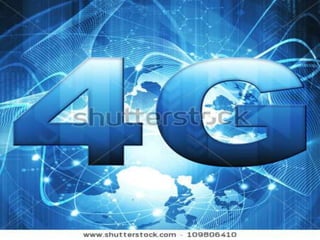
4G Mobile communication Technology
- 3. Introduction 4G systems solves the problems of 3G systems It provides a wide variety of new services from high- quality voice to high-definition video to high-data-rate wireless channels.
- 5. Symbols: 1xRTT = 2.5G CDMA data service up to 384 kbps AMPS = advanced mobile phone service CDMA = code division multiple access EDGE = enhanced data for global evolution FDMA = frequency division multiple access GPRS = general packet radio system GSM = global system for mobile NMT = Nordic mobile telephone PDC = personal digital cellular PSTN = pubic switched telephone network TACS = total access communications system TDMA = time division multiple access
- 6. HistoryTechnology 1G 2G 2.5G 3G 4G Design began 1970 1980 1985 1990 2000 Implementat ion 1984 1991 1999 2002 2010? Services Analog voice,synchr onous data to 9.6kbps Digital voice, Short messages Higher capacity, Packetized data Higher capacity,broa d band data up to 2mbps Higher capacity completely,I P oriented data to hundreds of megabytes Standards AMPS,TACS, NMT etc TDMA, GSM,CDMA GPRS,EDGE WCDMA,CD MA2000 Single standard Data bandwidth 1.9kbps 14.4kbps 384kbps 2mbps 200mbps Multiplexing FDMA TDMA,CDM A TDMA,CDM A CDMA CDMA
- 7. Vision of 4G Technology This new generation of wireless is intended to complement and replace the 3G systems, Accessing information anywhere, anytime, with a seamless connection to a wide range of information and services. The 4G infrastructures are data,pictures,video etc… and consists of a set of various networks using IP (Internet protocol) as a common protocol.
- 8. What is 4G ?? 4G systems is the cellular broadband wireless access systems have been attracting much interest in the mobile communication arena. It will support the wireless networks.
- 9. 4G Technology Based on the developing the trends of mobile communication, 4G will have broader bandwidth, higher data rate, and smoother and quicker handoff. It’s main features are: 1. Application adaptability 2. Being highly dynamic
- 11. Key Of The 4G Technology1. Multiple input –Multiple output MIMO uses signal multiplexing between multiple transmitting antennas (space multiplex) and time or frequency. It is well suited to OFDM. In principle, MIMO is more efficient when many multiple path signals are received. it is possible to process independent time symbols as soon as the OFDM waveform is correctly designed for the channel.
- 12. Key Of The 4G Technology
- 13. Key of the 4G Technology2.Handover and Mobility: Handover technologies based on mobile IP technology have been considered for data and voice. Mobile IP techniques are slow but can be accelerated with classical methods (hierarchical, fast mobile IP). These methods are applicable to data and probably also voice.
- 14. Security The heterogeneity of wireless networks complicates the security issue. Dynamic reconfigurable, adaptive, and lightweight security mechanisms should be developed. AAA (Authentication Authorization Auditing) protocols provide a framework for such suffered especially for control plane functions and installing security policies in the mobile node such as encryption, decryption and filtering.
- 15. Benifits Benefits for Operators: Higher bandwidths. Lower cost of networks and equipment. The use of licence-exempt spectrum. Higher capacity and QoS enhancement. Higher revenue. Benefits for users: Access to broadband multimedia services with lower cost and where mostly needed. Inter-network roaming.
- 16. Reconfiguration Technology In order to use the large variety of services and wireless networks, multimode user terminals are essential as they can adapt to different wireless networks by reconfiguring themselves. Challenges: User preference profiles Inter-system handover mechanisms and criteria Software download mechanisms
- 17. Benefits for users: 1. Select network depending on service requirements and cost. 2. Connect to any network – Worldwide roaming. 3.Access to new services. Benefits for Operators: 1. Incorporate service enhancements and improvements. 2. Correction of software bugs and upgrade of terminals. 3.Rapid development of new personalised and customised services. Benefits for Manufacturers: 1. Single platform for all markets. 2.Increased flexible and efficient production.
- 18. Applications VIRTUAL PRESENCE: This means that 4G provides user services at all times, even if the user is off-site. VIRTUAL NAVIGATION: 4G provides users with virtual navigation through which a user can access a database of the streets, buildings etc. CRISIS MANAGEMENT: Natural disasters can cause break down in communication systems. In today’s world it might take days or 7 weeks to restore the system. But in 4G it is expected to restore such crisis issues in a few hours.
- 19. Conclusion As the history of mobile communications shows, attempts have been made to reduce a number of technologies to a single global standard. Future wireless networks will need to support diverse IP multimedia applications to allow sharing of resources among multiple users. The fourth generation promises to fulfill the goal of PCC (personal computing and communication)—a vision that affordably provides high data rates everywhere over a wireless network.
- 21. A Presentation By C .Vamsi Krishna
